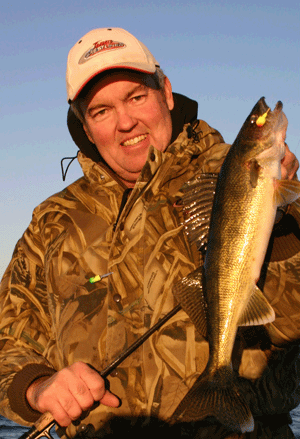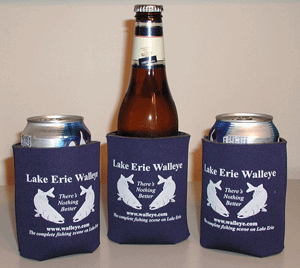|
Scale Back For Late Fall
Walleyes
by Ron Anlauf
Depending on where you are, your last chance for finding open
 water
walleyes could very well be on a river. While the bigger more well known
rivers like the Mississippi get all of the attention, there’s plenty of
excellent opportunities available right now, it’s just that it could be
on a much smaller scale. Small rivers can really turn on late in the
season, and the action may be a lot better than you might expect. water
walleyes could very well be on a river. While the bigger more well known
rivers like the Mississippi get all of the attention, there’s plenty of
excellent opportunities available right now, it’s just that it could be
on a much smaller scale. Small rivers can really turn on late in the
season, and the action may be a lot better than you might expect.
Late fall walleyes on large rivers can be spread out for miles, and
finding the active ones may take a little doing. Fish can be found from
directly below a dam to as much as ten or twenty miles downstream, and
only a few are probably active at any given time. Compare that to small
rivers where the areas that can hold fish are rather limited, and can be
quickly found and fished.
Come late fall small river walleyes stack up in small easily defined
areas, and can become extremely vulnerable. Not only can they be found
in specific areas they’re also usually deep into a serious feeding
binge. The combination of these two factors plays right into the hands
of late season anglers. Specific areas include deep holes ( the deepest
you can find ), that provide walleyes with a safe home for the winter.
Finding holes with enough depth can take a little work, and will require
a little investigation. Dams are one of the first places to look and can
make finding late season walleyes a snap. If your little river has a dam
you can bet there’ll be a least a few walleyes using the area. Another
potential hangout exists where a dam has been previously removed. The
same attractions ( like depth and current ), are probably still there
and can hold plenty of fish.
With the absence of the aforementioned more time will have be spent
looking for less obvious wintering grounds. Deeper holes are still the
ticket but they’ll have to be of a natural origin. Look for outside
bends where a river makes a hard turn and the current has cut a deep
hole near the bank. You’ll also want to look for shoreline eddies (
where the current reverses itself), and check for depth. If they’re deep
enough they too can hold plenty of fish. Another key to look for would
be a large flat adjacent to deep water. Flats offer many feeding
opportunities and the combination can make for the perfect late fall
fishing hole.
While wintering holes may be rather small in size there are specific
areas that you should look for. One of the keys to finding walleyes that
are holed up is to fish current breaks. Current breaks are high
percentage spots that can help to concentrate fish and deserve a good
deal of attention. Look for the break(where fast water meets slack), and
get to work.
An effective method for working current breaks is to simply drop an
anchor, trying to keep the boat positioned right on the edge, and
lifting and dropping a jig and minnow combination along the bottom. Jig
size can vary depending on how deep your fishing and how much current
you’re dealing with. The key is to use as small a jig as possible while
retaining the ability to stay in contact with bottom. Quite often that
will mean jigs in the 1/16 to 3/8 ounce size, and as heavy as a 1/2
ounce. Tip the jig with a smaller minnow like a fathead or shiner and
lift and drop the jig, letting it bang into the bottom. Strikes can be
difficult to detect and fish are often not felt until you lift the bait.
If you feel a little extra weight, set the hook. If you’re missing fish
trying waiting for a few seconds before the set. Trailer hooks can help
with short strikers but may be more trouble than their worth, as they
increase your chances of getting hung up and will also pick up a lot of
unwanted debris. An excellent option is Northland Tackles single hook
stinger which doesn’t pick up as much debris but will still nail the
short strikers.
Another method that Team Crestliner member Rick Olson uses that can
help with missed fish includes tipping a jig with two minnows instead of
one. Rick will run the hook through the mouth of the first minnow and
out behind the head as far as possible, and then hook a second one
through the lips. “If you set the hook and miss a fish quickly drop the
bait back down and hold on. Many times fish will come back and take the
bait completely and give you a much needed second chance.”
After you’ve thoroughly worked the current break try casting a jig
into the slack water and slowly crawl the bait back to the boat. And
don’t be afraid to cast into extremely shallow water. Although walleyes
need deep water to make it through the winter, they’ll often move
shallow to feed.
While many inland lakes are going through the process of developing
ice, rivers can remain open and fishable for another several weeks or
more. The presence of current delays the freezing process and can keep
rivers accessible. Some of the best small river action I’ve experienced
occurred when I had to break ice out of a slack water area along a
current break in order to have place to fish. It tooksome doing but by
running the boat up on the ice and waiting for it to settle I was able
to break it out one piece at a time. See you on the river. |





 water
walleyes could very well be on a river. While the bigger more well known
rivers like the Mississippi get all of the attention, there’s plenty of
excellent opportunities available right now, it’s just that it could be
on a much smaller scale. Small rivers can really turn on late in the
season, and the action may be a lot better than you might expect.
water
walleyes could very well be on a river. While the bigger more well known
rivers like the Mississippi get all of the attention, there’s plenty of
excellent opportunities available right now, it’s just that it could be
on a much smaller scale. Small rivers can really turn on late in the
season, and the action may be a lot better than you might expect.